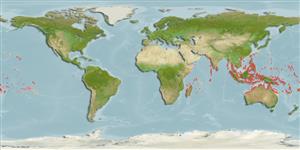Common names from other countries
Environment: milieu / climate zone / depth range / distribution range
Ecologia
Associadas(os) a recifes; intervalo de profundidade 0 - 5 m (Ref. 75835). Tropical; 31°N - 28°S, 42°E - 124°W
Indo-Pacific.
Length at first maturity / Tamanho / Peso / Idade
Maturity: Lm ? range ? - ? cm Max length : 8.5 cm SHL macho/indeterminado; (Ref. 821); common length : 5.0 cm SHL macho/indeterminado; (Ref. 349); Idade máx. registada: 3.00 anos (Ref. 117181)
One of the most frequently collected Turbinidae in the area, mainly for food. Shell also used as material for making buttons (Ref. 349).
Life cycle and mating behavior
Maturidade | Reprodução | Desova | Ovos | Fecundidade | Larvas
Members of the order Patellogastropoda are mostly gonochoric and broadcast spawners. Life cycle: Embryos develop into planktonic trocophore larvae and later into juvenile veligers before becoming fully grown adults.
Poutiers, J.M. 1998. (Ref. 349)
Categoria na Lista Vermelha da IUCN (Ref. 130435: Version 2024-1)
Categoria CITES (Ref. 108899)
Not Evaluated
Not Evaluated
Ameaça para o homem
Harmless
Utilização humana
Pescarias: espécies comerciais
| FishSource | Sea Around Us
Ferramentas
Fontes da internet
Estimates based on models
Preferred temperature
(Ref.
115969): 25.6 - 29.3, mean 28.6 (based on 2967 cells).
Resiliência
Elevada, tempo mínimo de duplicação da população menor que 15 meses (K=0.58; tmax=3).
Prior r = 1.19, 95% CL = 0.79 - 1.79, Based on 1 data-limited stock assessment.
Vulnerabilidade
Low vulnerability (22 of 100).
